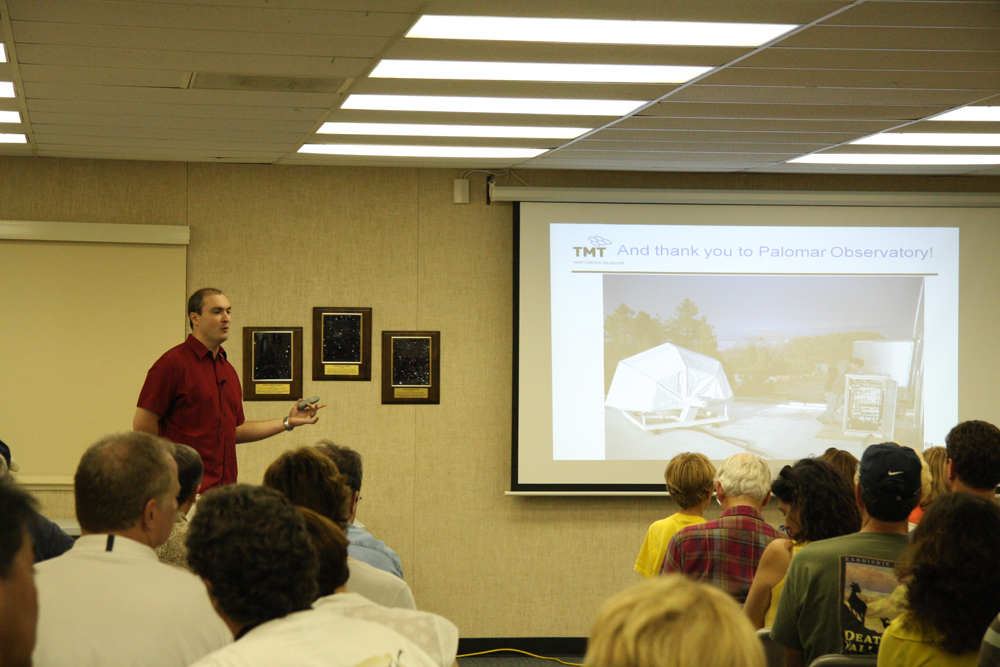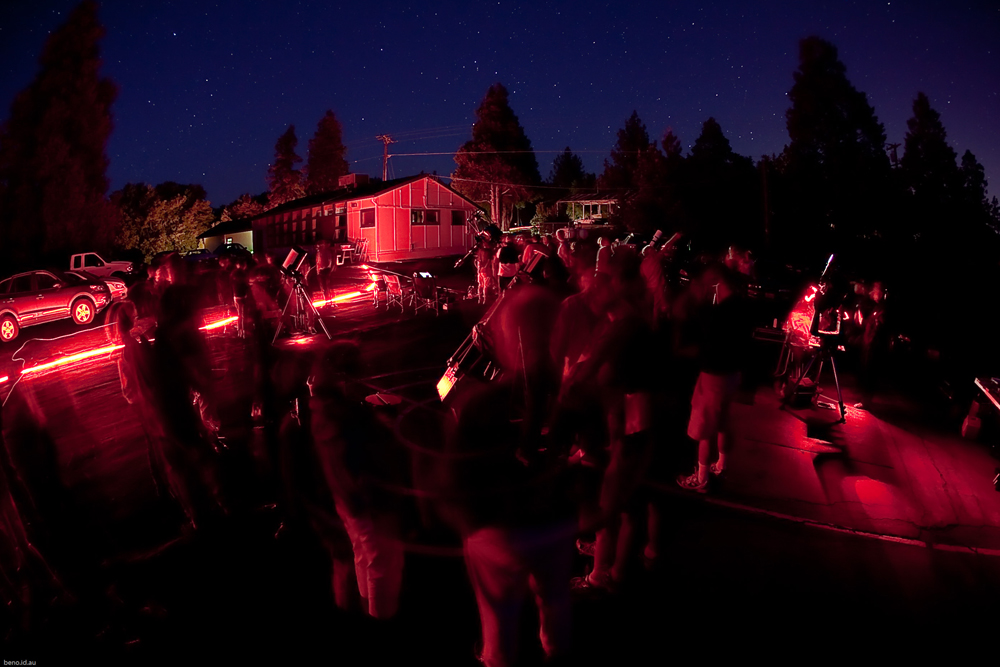 Thanks to Palomar Observatory docent Roger for bringing in the cake!
Thanks to Palomar Observatory docent Roger for bringing in the cake!
Tuesday, June 29, 2010
142 Years Ago Today
George Ellery Hale was born 142 years ago today. Why not celebrate by watching The Journey to Palomar?
 Thanks to Palomar Observatory docent Roger for bringing in the cake!
Thanks to Palomar Observatory docent Roger for bringing in the cake!
 Thanks to Palomar Observatory docent Roger for bringing in the cake!
Thanks to Palomar Observatory docent Roger for bringing in the cake!
Labels:
George Ellery Hale,
Journey to Palomar
Modeling the 200-inch Telescope
I am a big fan of model telescopes. If you are also enamored with them be sure to check out the August 2010 issue of Sky & Telescope magazine for Dan Ryan's article, Modeling the 200-inch Telescope. There you will find the story of how Dan built his model of one of my favorite telescopes.
Below is a photo of his model that did not appear with the article. I am sure that you will agree that Dan did a super job.
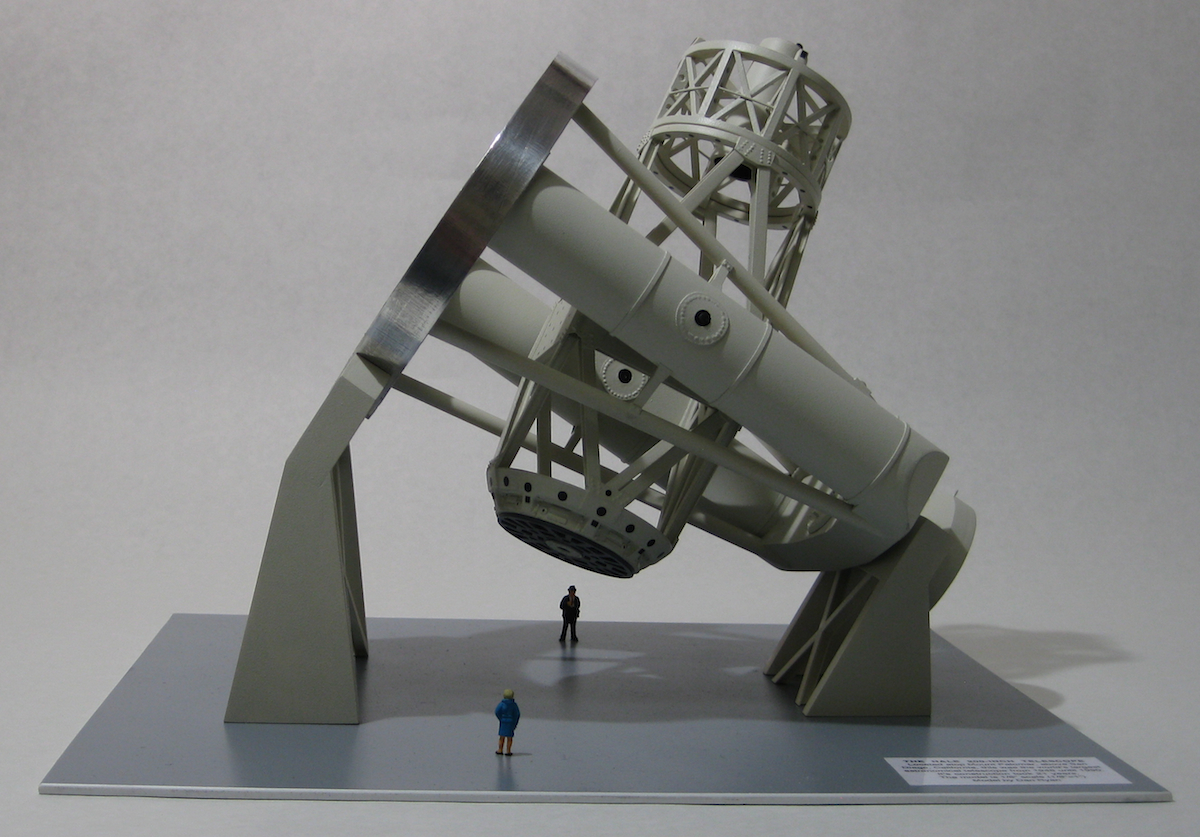
Below is a photo of his model that did not appear with the article. I am sure that you will agree that Dan did a super job.

Saturday, June 26, 2010
Partial Lunar Eclipse, June 26, 2010
Here are a few pics I shot this morning of the partial lunar eclipse with a digital SLR camera on a tripod.
Partial eclipses can be tricky. To capture the illumination on the eclipsed portion of the Moon you pretty much need to over expose the rest.
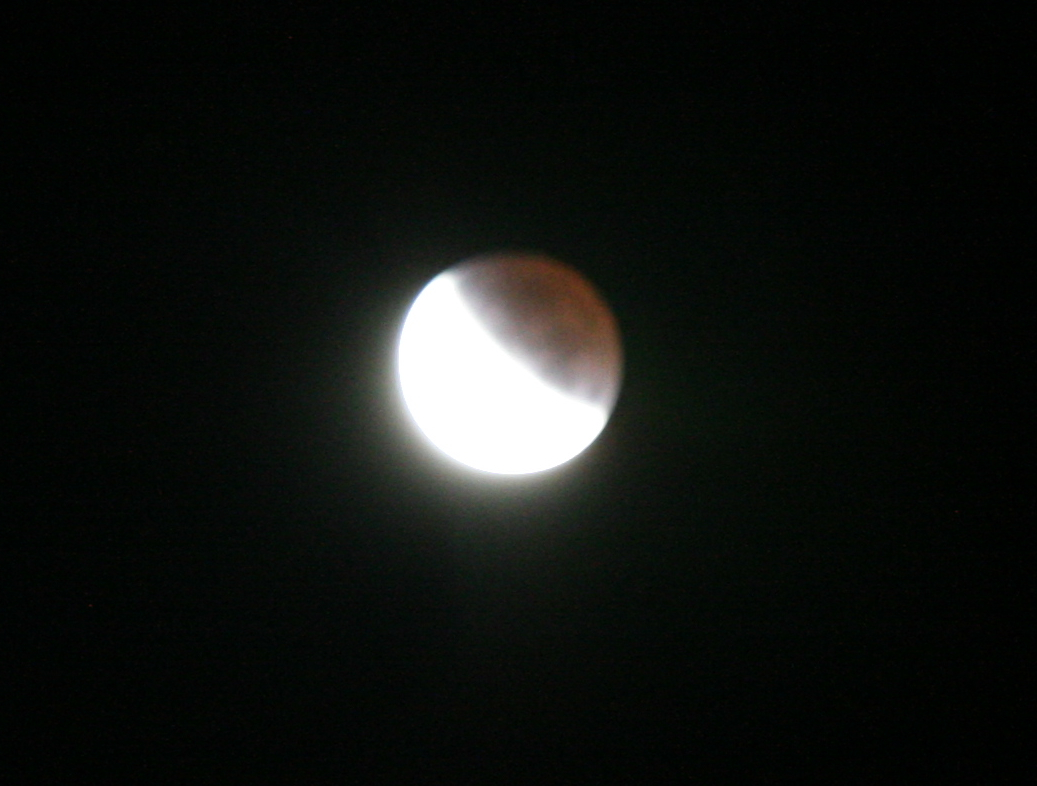 The orange color in the eclipsed portion of the Moon comes from the orange glow of sunsets and sunrises around Earth shining on to the Moon.
The orange color in the eclipsed portion of the Moon comes from the orange glow of sunsets and sunrises around Earth shining on to the Moon.
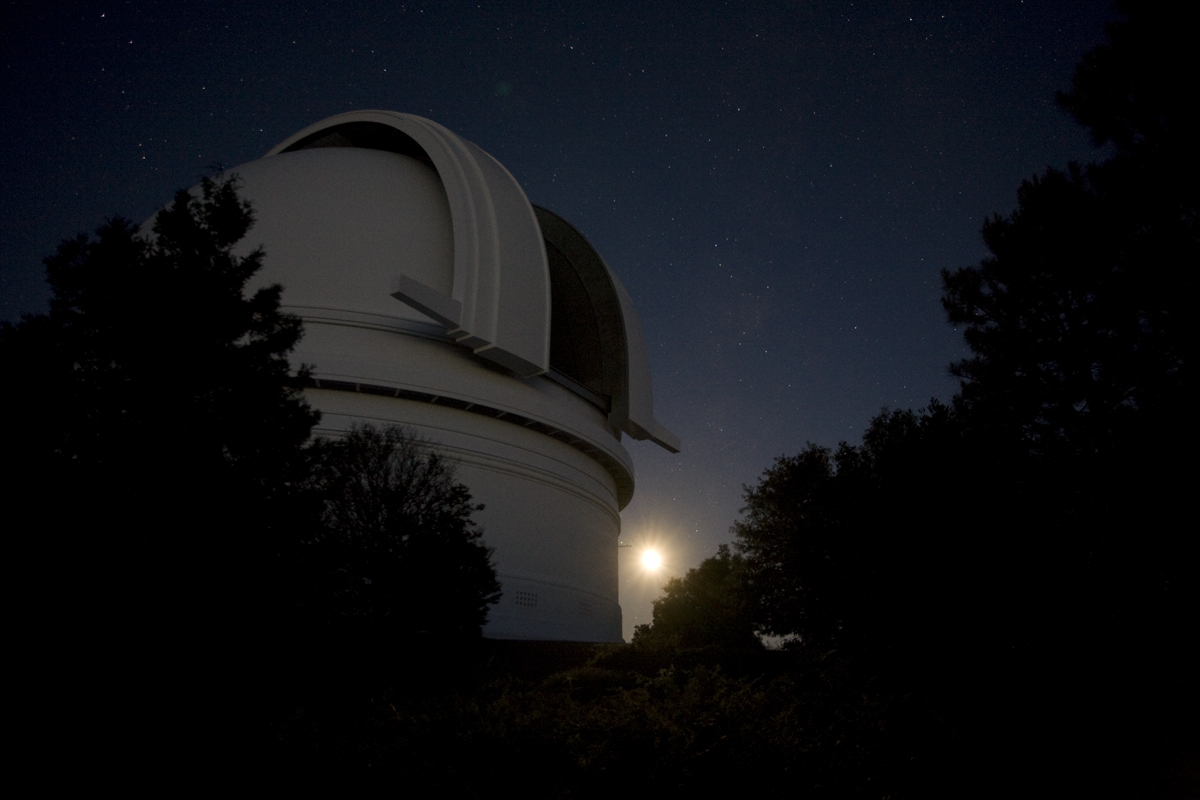 Trying to capture much in the way of landscape (or telescope dome) also gives you the over exposed Moon phenomenon.
Trying to capture much in the way of landscape (or telescope dome) also gives you the over exposed Moon phenomenon.
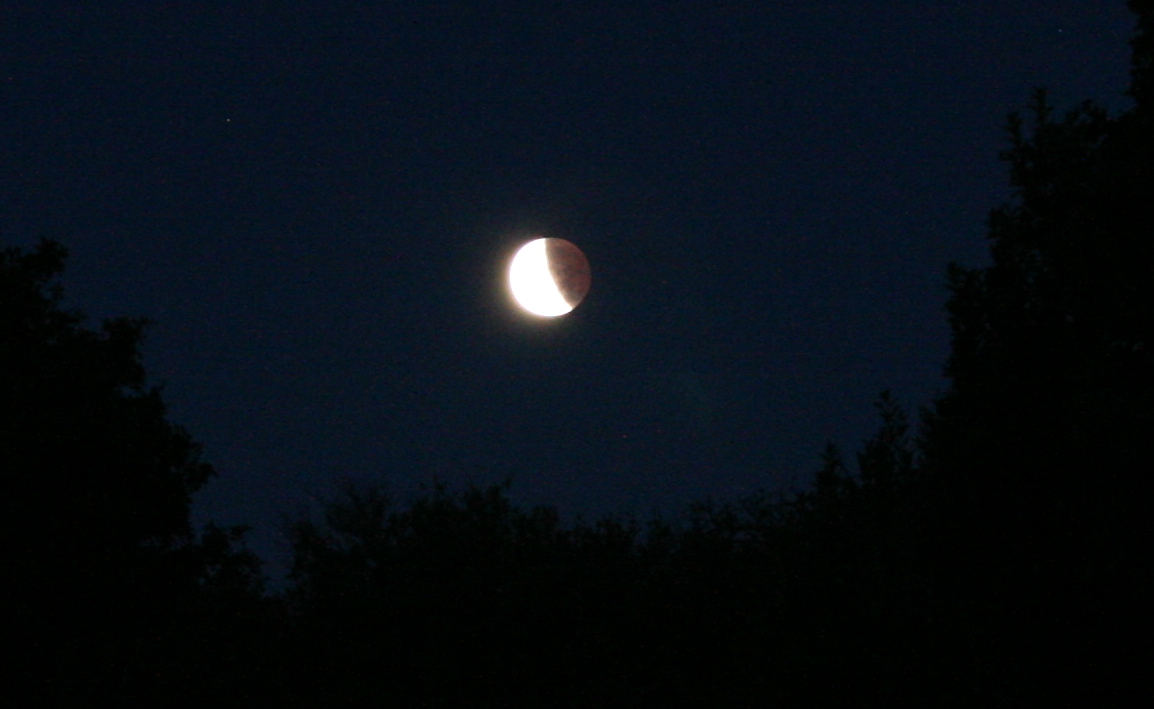
But as the Moon got lower and we got closer to twilight it began to be possible to start to be easier to catch more of the landscape.
 Finally the glow of twilight made it easier to capture all the detail on the land and sky that I was after, but I no longer had a good vantage point to combine the dome and sky the way I was hoping to.
Finally the glow of twilight made it easier to capture all the detail on the land and sky that I was after, but I no longer had a good vantage point to combine the dome and sky the way I was hoping to.
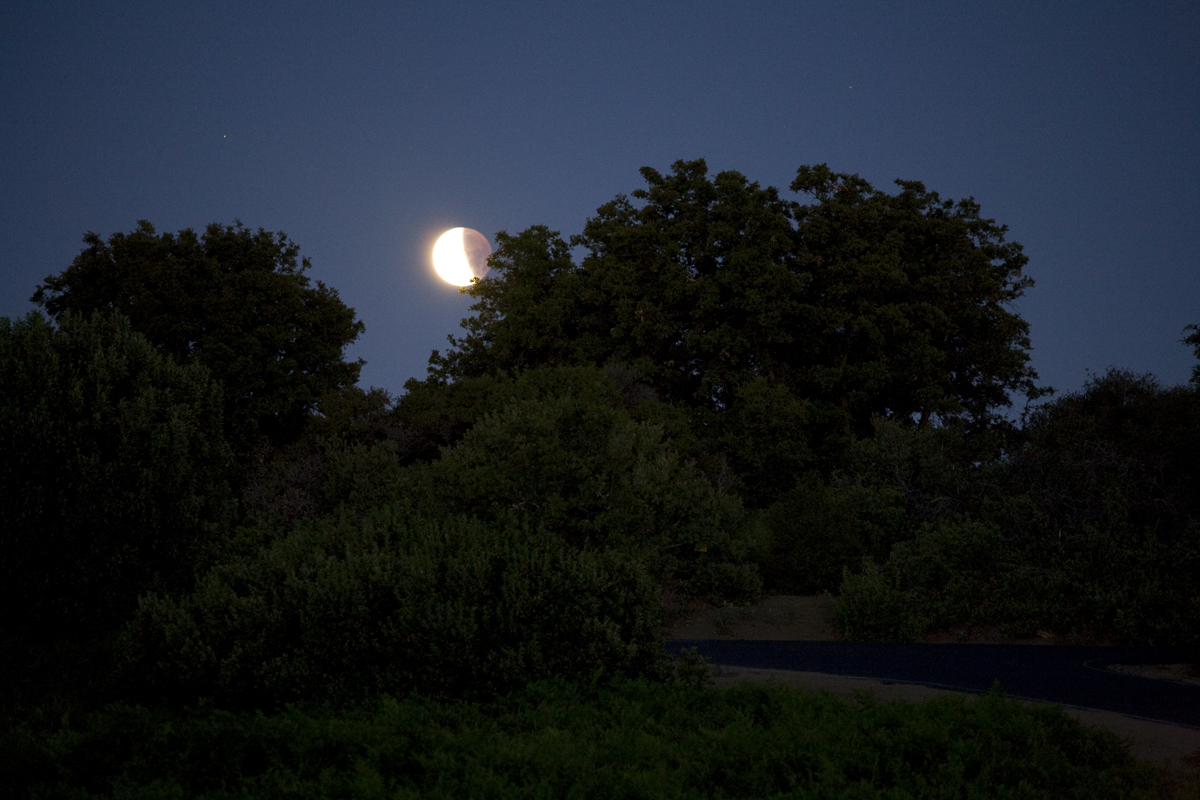
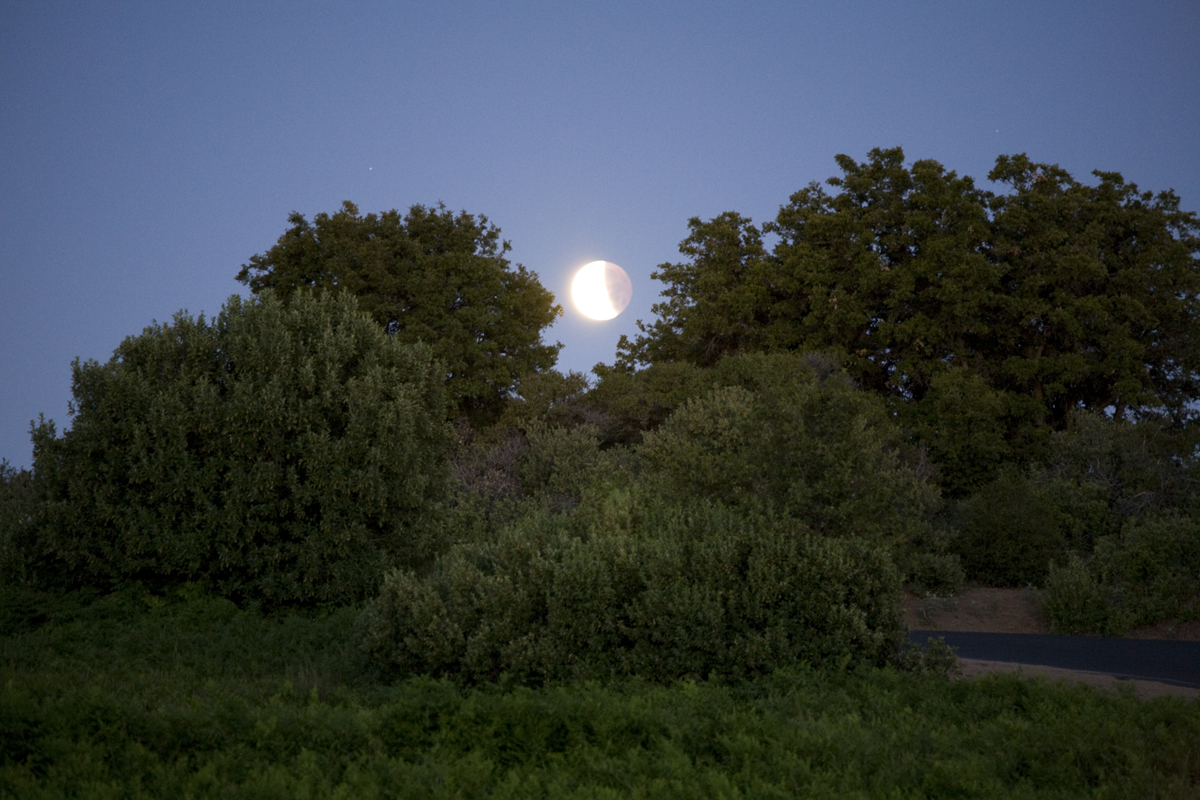
Eventually the terrain got in the way and I had to relocate. Here is the setting Moon from an overlook on Palomar Mountain. The valleys below are filled with the "marine layer" clouds. Notice that the entire Moon now appears to be orange in color. This isn't due to the eclipse, but rather the Moon's low position in the sky. Just as a setting Sun appears orange, so does the Moon.
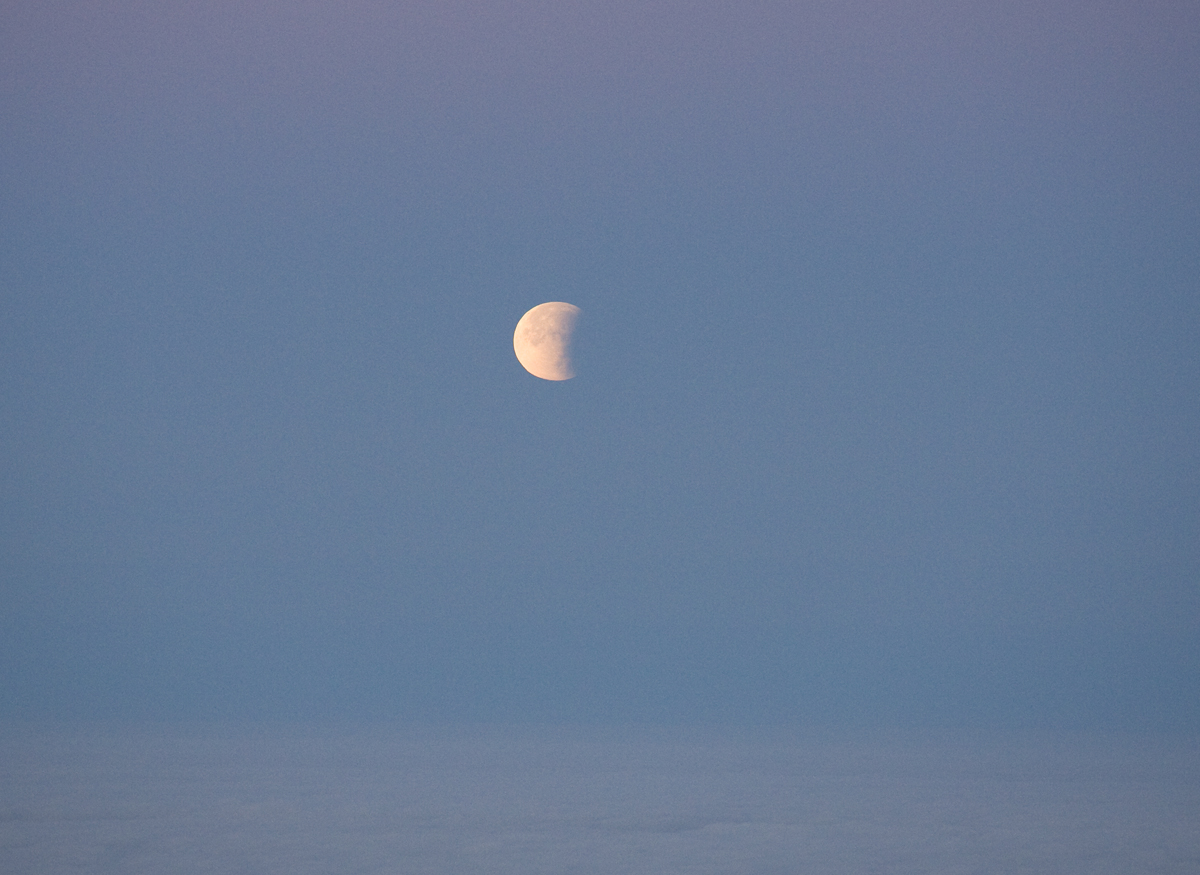
The Moon in Earth's Shadow, just before moonset:
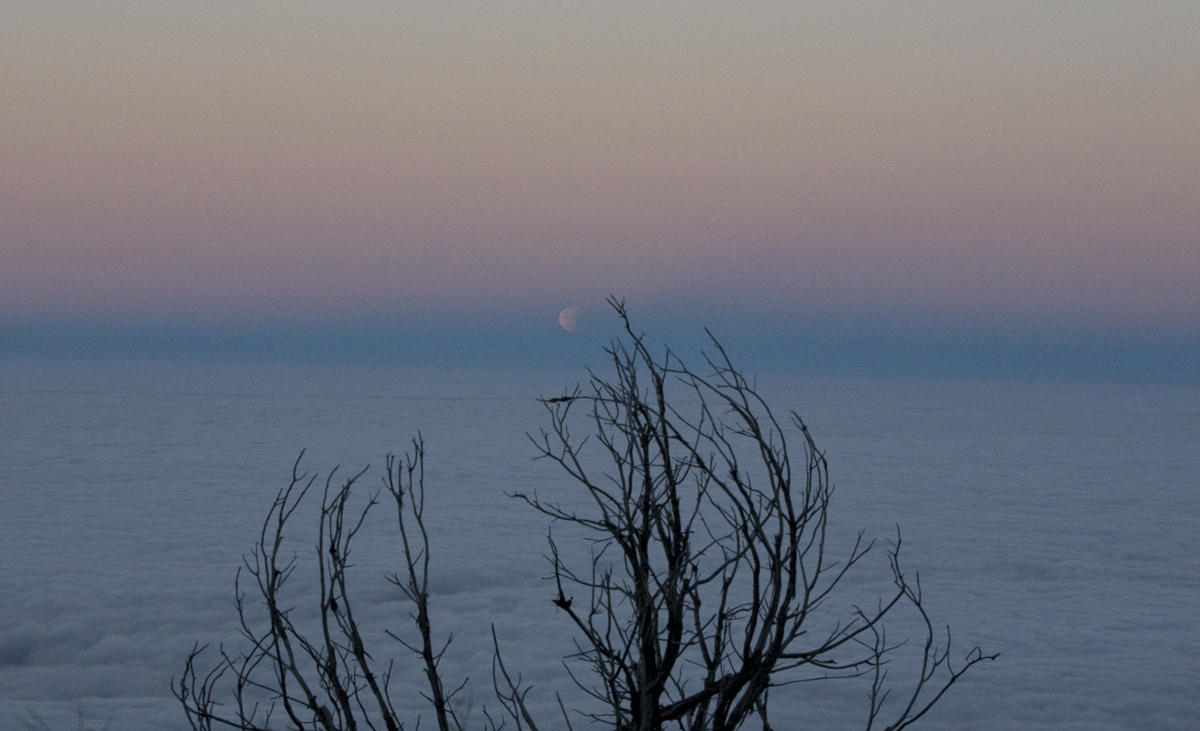 Much earlier, just before the maximum eclipse we had a pass of the International Space Station. Fortunately, I was able to switch targets in time. Here is the International Space Station as it passed across the sky near Jupiter with the dome of the Hale Telescope on the right.
Much earlier, just before the maximum eclipse we had a pass of the International Space Station. Fortunately, I was able to switch targets in time. Here is the International Space Station as it passed across the sky near Jupiter with the dome of the Hale Telescope on the right.
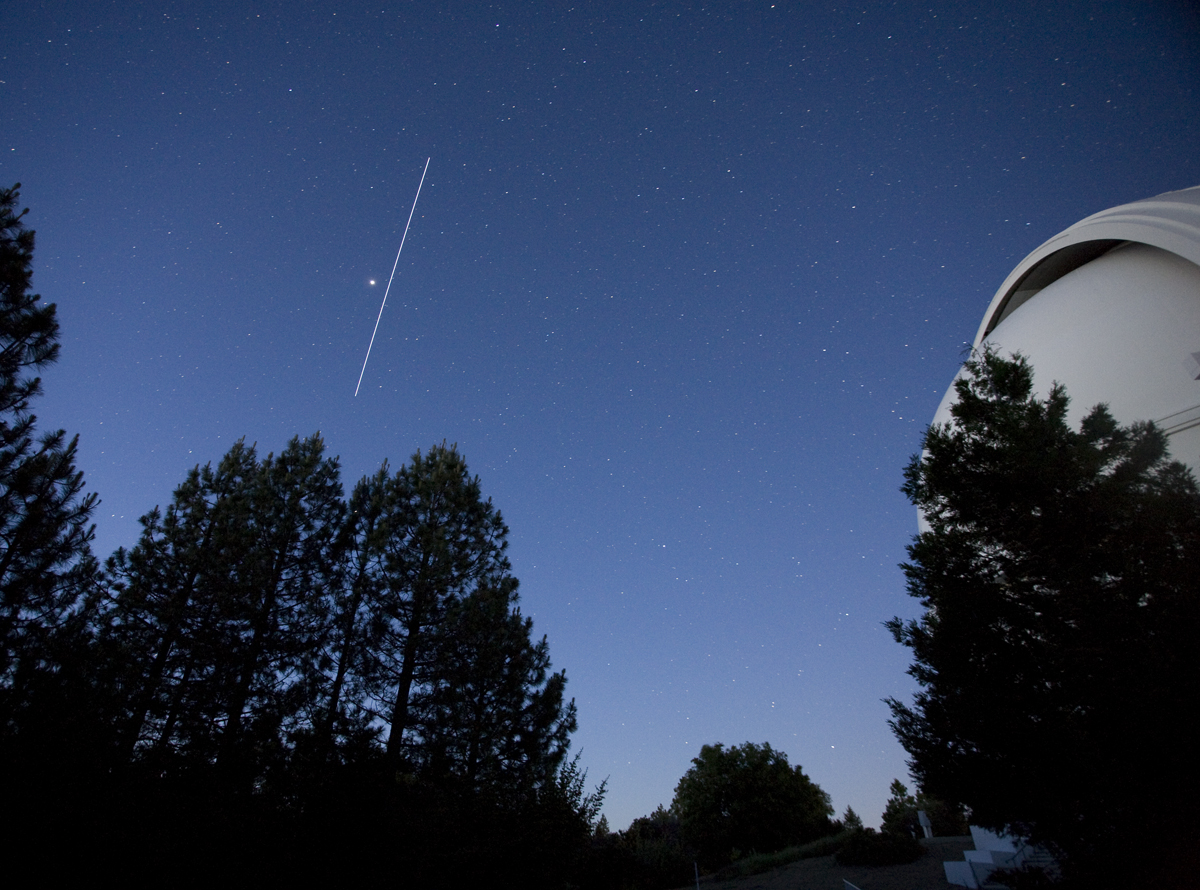
Partial eclipses can be tricky. To capture the illumination on the eclipsed portion of the Moon you pretty much need to over expose the rest.
 The orange color in the eclipsed portion of the Moon comes from the orange glow of sunsets and sunrises around Earth shining on to the Moon.
The orange color in the eclipsed portion of the Moon comes from the orange glow of sunsets and sunrises around Earth shining on to the Moon. Trying to capture much in the way of landscape (or telescope dome) also gives you the over exposed Moon phenomenon.
Trying to capture much in the way of landscape (or telescope dome) also gives you the over exposed Moon phenomenon.
But as the Moon got lower and we got closer to twilight it began to be possible to start to be easier to catch more of the landscape.
 Finally the glow of twilight made it easier to capture all the detail on the land and sky that I was after, but I no longer had a good vantage point to combine the dome and sky the way I was hoping to.
Finally the glow of twilight made it easier to capture all the detail on the land and sky that I was after, but I no longer had a good vantage point to combine the dome and sky the way I was hoping to.

Eventually the terrain got in the way and I had to relocate. Here is the setting Moon from an overlook on Palomar Mountain. The valleys below are filled with the "marine layer" clouds. Notice that the entire Moon now appears to be orange in color. This isn't due to the eclipse, but rather the Moon's low position in the sky. Just as a setting Sun appears orange, so does the Moon.

The Moon in Earth's Shadow, just before moonset:
 Much earlier, just before the maximum eclipse we had a pass of the International Space Station. Fortunately, I was able to switch targets in time. Here is the International Space Station as it passed across the sky near Jupiter with the dome of the Hale Telescope on the right.
Much earlier, just before the maximum eclipse we had a pass of the International Space Station. Fortunately, I was able to switch targets in time. Here is the International Space Station as it passed across the sky near Jupiter with the dome of the Hale Telescope on the right.
Bee Careful
Here is the reason my eclipse pictures have not yet been posted.
 This swarm of bees, in an oak tree at Palomar Observatory, is directly above the walkway that takes our visitors up the dome of the Hale Telescope. As such I am spending most of my day outside directing our visitors toward a safer, but longer, route to the dome.
This swarm of bees, in an oak tree at Palomar Observatory, is directly above the walkway that takes our visitors up the dome of the Hale Telescope. As such I am spending most of my day outside directing our visitors toward a safer, but longer, route to the dome.
UPDATE: Thankfully, the bees have decided to move on.
 This swarm of bees, in an oak tree at Palomar Observatory, is directly above the walkway that takes our visitors up the dome of the Hale Telescope. As such I am spending most of my day outside directing our visitors toward a safer, but longer, route to the dome.
This swarm of bees, in an oak tree at Palomar Observatory, is directly above the walkway that takes our visitors up the dome of the Hale Telescope. As such I am spending most of my day outside directing our visitors toward a safer, but longer, route to the dome.UPDATE: Thankfully, the bees have decided to move on.
Friday, June 25, 2010
Partial Lunar Eclipse Saturday Morning
Early tomorrow (Saturday) morning the moon with move into Earth's shadow producing a partial lunar eclipse. The times for those of us out west, coupled with how it will appear are on the diagram below:

One of the great things about a lunar eclipse that they are easy and, unlike a solar eclipse, safe to view. No optical aid is necessary to view the event, although a pair of binoculars can help the view.
For those in the San Diego area the National Weather service is calling for a deep marine layer, which could block the view. Palomar Observatory is not open for viewing of the eclipse, but any clear location will do to see the event.
This partial eclipse is a warm-up act for the total lunar eclipse that will happen the night of December 20, 2010.
You can learn more from StarDate, NASA, or Sky & Telescope magazine.

One of the great things about a lunar eclipse that they are easy and, unlike a solar eclipse, safe to view. No optical aid is necessary to view the event, although a pair of binoculars can help the view.
For those in the San Diego area the National Weather service is calling for a deep marine layer, which could block the view. Palomar Observatory is not open for viewing of the eclipse, but any clear location will do to see the event.
This partial eclipse is a warm-up act for the total lunar eclipse that will happen the night of December 20, 2010.
You can learn more from StarDate, NASA, or Sky & Telescope magazine.
Thursday, June 24, 2010
Odyssey of the Giant Eye
Jeff Smith of the San Diego Reader just finished a two part article on the 1947 job that Belyea Truck company did in moving of Palomar's 200-inch mirror from Caltech to Palomar Mountain.
Check out Part 1: Odyssey of the Giant Eye and Part 2: The Giant Eye Rolls Uphill by clicking on the links.
Spoiler Alert: The mirror made it safely to Palomar. Even so, the articles are a good read.
Below is a picture taken just outside the dome of the 200-inch telescope just after the mirror arrived on site. Lead driver Lloyd Green can be seen shaking hands with owner Jack Belyea. The trailer with the mirror crate is behind them.

Check out Part 1: Odyssey of the Giant Eye and Part 2: The Giant Eye Rolls Uphill by clicking on the links.
Spoiler Alert: The mirror made it safely to Palomar. Even so, the articles are a good read.
Below is a picture taken just outside the dome of the 200-inch telescope just after the mirror arrived on site. Lead driver Lloyd Green can be seen shaking hands with owner Jack Belyea. The trailer with the mirror crate is behind them.

Wednesday, June 23, 2010
A Dark Skies Video from McDonald Observatory
Check out the new video below from McDonald Observatory:
Here is a direct link to the video on YouTube.
McDonald Observatory will also be be promoting dark skies awareness through its
nationally syndicated StarDate radio program, its Spanish-language radio program Universo.
The radio programs will feature dark skies information daily in the coming week (June 28-July 4). For more information on these programs and to find a station in your area, visit stardate.org or radiouniverso.org
For more information visit the McDonald Observatory’s Dark Skies Initiative site.
Here is a direct link to the video on YouTube.
McDonald Observatory will also be be promoting dark skies awareness through its
nationally syndicated StarDate radio program, its Spanish-language radio program Universo.
The radio programs will feature dark skies information daily in the coming week (June 28-July 4). For more information on these programs and to find a station in your area, visit stardate.org or radiouniverso.org
For more information visit the McDonald Observatory’s Dark Skies Initiative site.
Tuesday, June 22, 2010
New Displays at the Observatory
Back in December I posted about The Known Universe, a new video from the American Museum of Natural History. It is part of a series of videos produced as a part of their Science Bulletins which are now on display in HD on a 50-inch monitor in the Palomar Observatory visitor center.
In case you have forgotten what The Known Universe video, here it is:
The other item that is newly on display is a Warren Sidereal Time Standard.

This is a Warren Sidereal Time Standard. It is an electromechanical device also known as a vibrating-string or -wire oscillator. It was used at the Palomar Observatory to help astronomers keep track of Sidereal Time, which is used to determine the locations of stars in the sky.
The first one was purchased and applied to the 18-inch Schmidt telescope in 1938. Shortly thereafter three more similar Warren standards were purchased and applied to the drive system of the 200—inch Hale Telescope.
The oscillating wire units were used to generate the proper sidereal frequency to drive the telescope tracking motors so as to keep up with Earth’s rotation, thereby keeping astronomical objects centered in the telescope’s field of view.
Electronic oscillators replaced the time standards in the early 1960's.
In case you have forgotten what The Known Universe video, here it is:
The other item that is newly on display is a Warren Sidereal Time Standard.

This is a Warren Sidereal Time Standard. It is an electromechanical device also known as a vibrating-string or -wire oscillator. It was used at the Palomar Observatory to help astronomers keep track of Sidereal Time, which is used to determine the locations of stars in the sky.
The first one was purchased and applied to the 18-inch Schmidt telescope in 1938. Shortly thereafter three more similar Warren standards were purchased and applied to the drive system of the 200—inch Hale Telescope.
The oscillating wire units were used to generate the proper sidereal frequency to drive the telescope tracking motors so as to keep up with Earth’s rotation, thereby keeping astronomical objects centered in the telescope’s field of view.
Electronic oscillators replaced the time standards in the early 1960's.
Monday, June 21, 2010
Palomar History Photo of the Week - June 21, 2010
 This may look like beginnings of Stonehenge or some other ancient stone-age calendar but it is actually the footings for the dome of the 200-inch telescope at Palomar. This aerial photo was taken June 30, 1936.
This may look like beginnings of Stonehenge or some other ancient stone-age calendar but it is actually the footings for the dome of the 200-inch telescope at Palomar. This aerial photo was taken June 30, 1936.Happy solstice!
Friday, June 18, 2010
Astrophoto Friday - Milky Way over Palomar
It is Astrophoto Friday. Today instead of a photo taken with one of the Palomar telescopes, it is time to see the sky from Palomar.
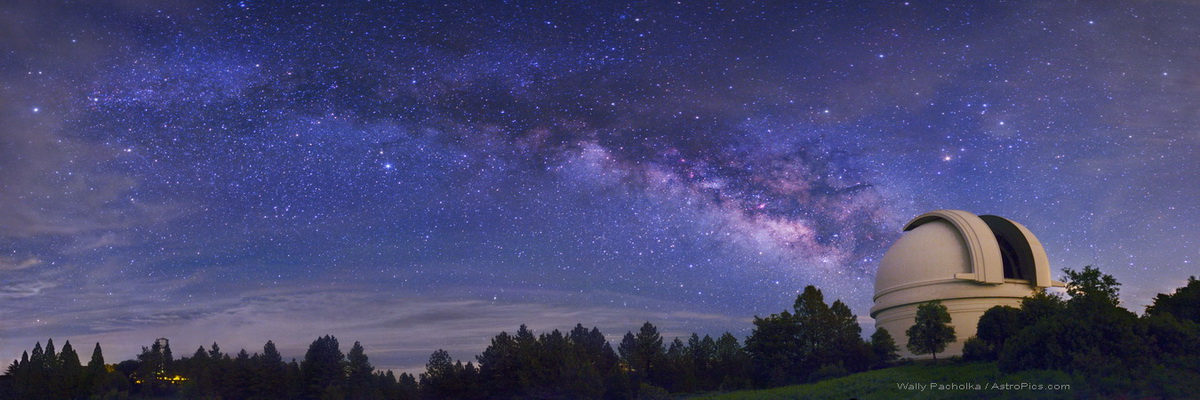
The Milky Way Galaxy over the Hale Telescope as captured by Wally Pacholka of AstroPics.com.
Wally recorded this image just over a week ago on the night of Thursday June 10, 2010. His photo serves as a reminder that the battle between astronomy and light pollution has not yet been lost and that the skies over Palomar are still beautiful and worth fighting for.

The Milky Way Galaxy over the Hale Telescope as captured by Wally Pacholka of AstroPics.com.
Wally recorded this image just over a week ago on the night of Thursday June 10, 2010. His photo serves as a reminder that the battle between astronomy and light pollution has not yet been lost and that the skies over Palomar are still beautiful and worth fighting for.
Labels:
astrophotos,
galaxies,
Hale Telescope,
Light Pollution
Monday, June 14, 2010
Palomar History Photo of the Week - June 14, 2010
Here is a press photo taken during construction of the 200-inch telescope:
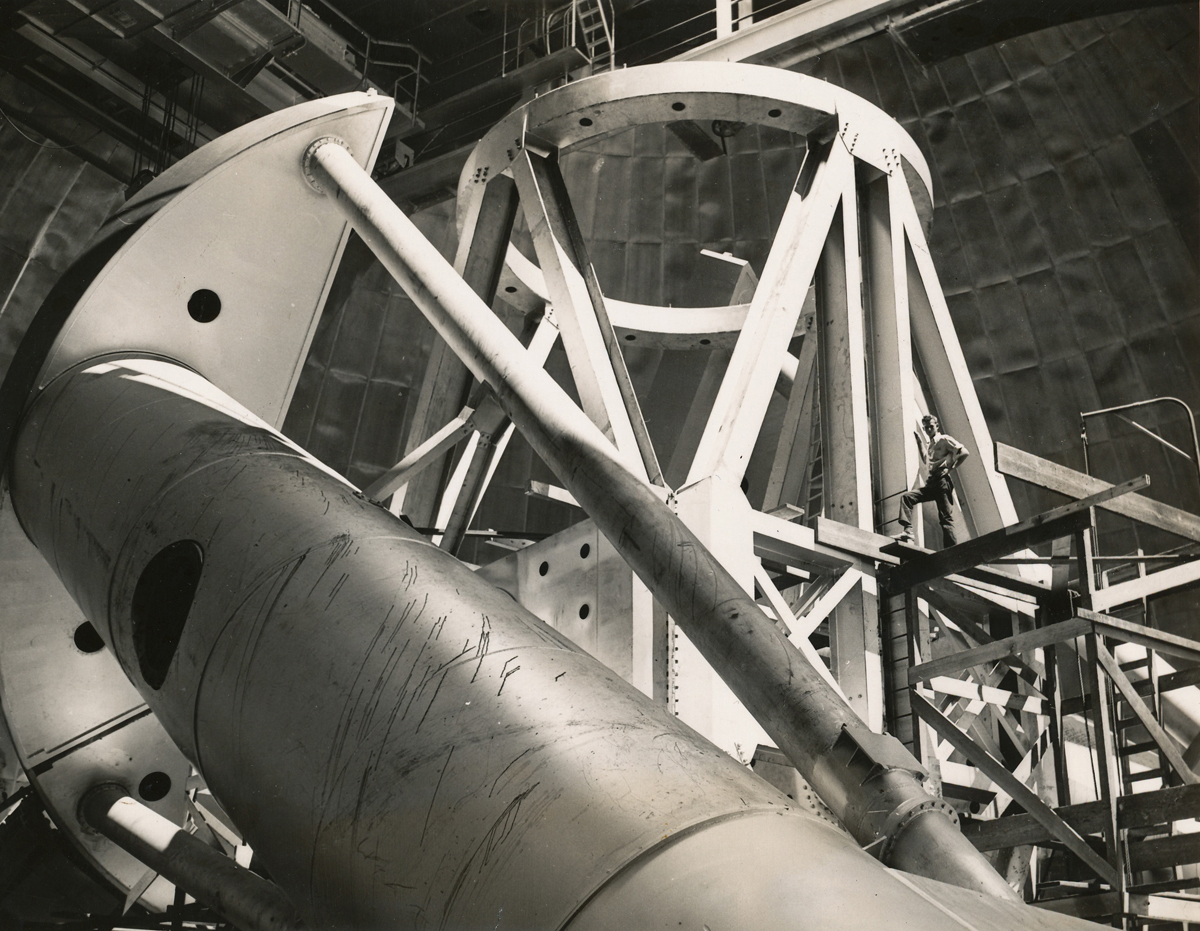
The caption to go with it:
Of course the mirror wasn't finished by the end of 1940. World War II eventually interrupted work on the glass, which wasn't finished at Caltech until October 1947. When this photo was taken the upper part of the telescope, which houses prime focus, had not yet been installed.

The caption to go with it:
WORKMEN ASSEMBLE GIANT PALOMAR MOUNTAIN TELESCOPE
PALOMAR MOUNTAIN, CALIF. - The sky end of the huge telescope tube as it appeared in upright position in the yoke assembly in the observatory atop Palomar Mountain in Southern California recently. The workman standing beside the telescope tube gives an impression of the size of the unit, installation of which was completed April 11. The 200-inch mirror for the telescope, which is now being polished at California Institute of Technology is expected to be completed in the latter part of 1940.
N-4/12/39 (s)
Of course the mirror wasn't finished by the end of 1940. World War II eventually interrupted work on the glass, which wasn't finished at Caltech until October 1947. When this photo was taken the upper part of the telescope, which houses prime focus, had not yet been installed.
Saturday, June 12, 2010
Spring on Palomar
"June Gloom" is in full swing for the lowlands below, but on Palomar Mountain we are experiencing a beautiful spring day.
As evidence of the nice weather from above the clouds, here are two photos taken from vantage points seldom seen by the visiting public.
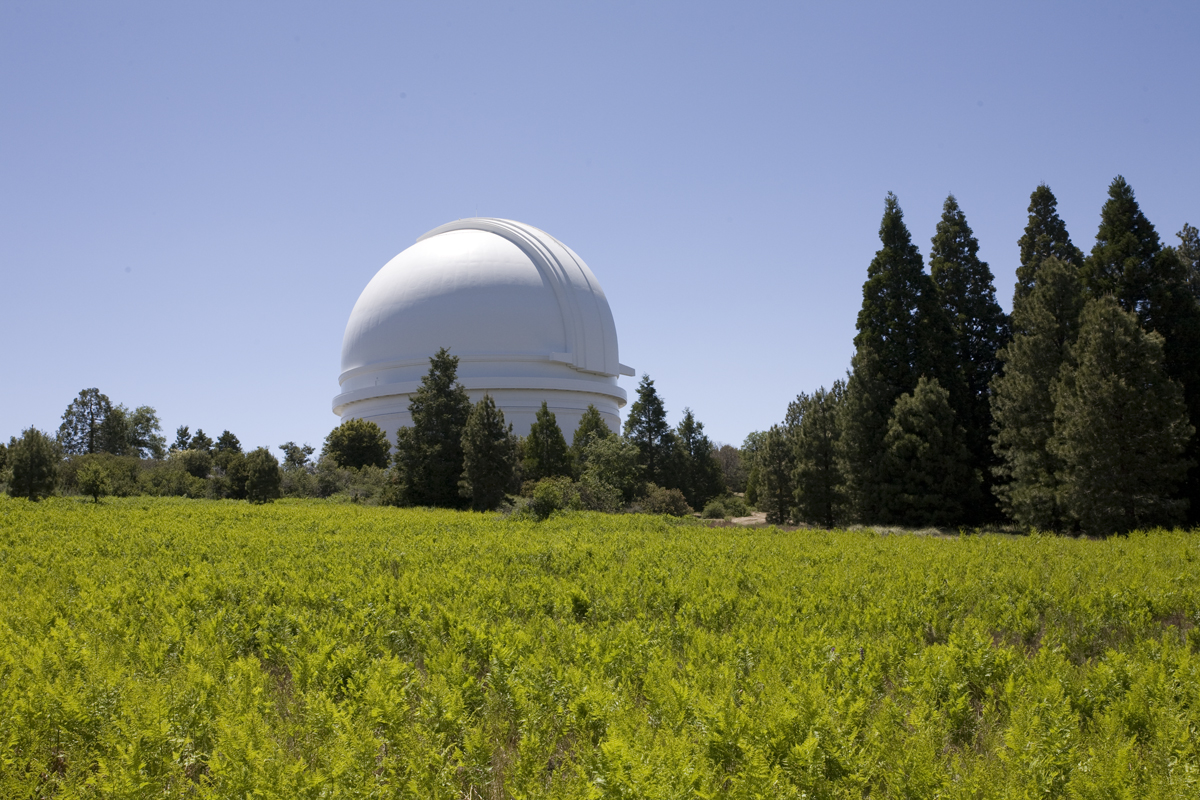 Looking west across a field of western bracken ferns (Pteridium aquilinum) toward the dome of the Hale Telescope.
Looking west across a field of western bracken ferns (Pteridium aquilinum) toward the dome of the Hale Telescope.
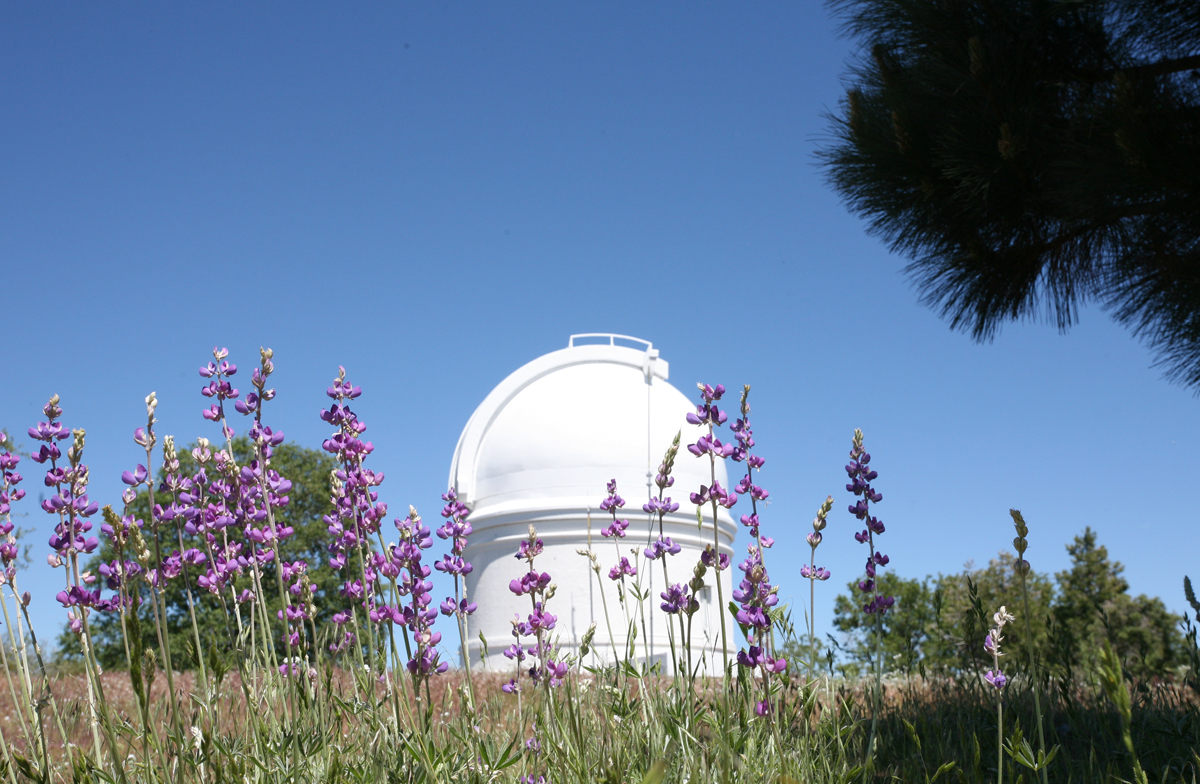 The dome that once housed the 18-inch Schmidt telescope standing well behind some Lupine (Lupinus albifrons, var. eminens) flowers. These purple flowers can be currently seen in bloom in many places on Palomar Mountain.
The dome that once housed the 18-inch Schmidt telescope standing well behind some Lupine (Lupinus albifrons, var. eminens) flowers. These purple flowers can be currently seen in bloom in many places on Palomar Mountain.
As evidence of the nice weather from above the clouds, here are two photos taken from vantage points seldom seen by the visiting public.
 Looking west across a field of western bracken ferns (Pteridium aquilinum) toward the dome of the Hale Telescope.
Looking west across a field of western bracken ferns (Pteridium aquilinum) toward the dome of the Hale Telescope. The dome that once housed the 18-inch Schmidt telescope standing well behind some Lupine (Lupinus albifrons, var. eminens) flowers. These purple flowers can be currently seen in bloom in many places on Palomar Mountain.
The dome that once housed the 18-inch Schmidt telescope standing well behind some Lupine (Lupinus albifrons, var. eminens) flowers. These purple flowers can be currently seen in bloom in many places on Palomar Mountain.
Labels:
18-inch schmidt,
Hale Telescope,
weather
Friday, June 11, 2010
Astrophoto Friday - A Bubble in Aquila
This week's astrophoto is another vintage shot (copyright 1965). It shows a planetary nebula in the constellation of Aquila (the Eagle) known as NGC 6781.
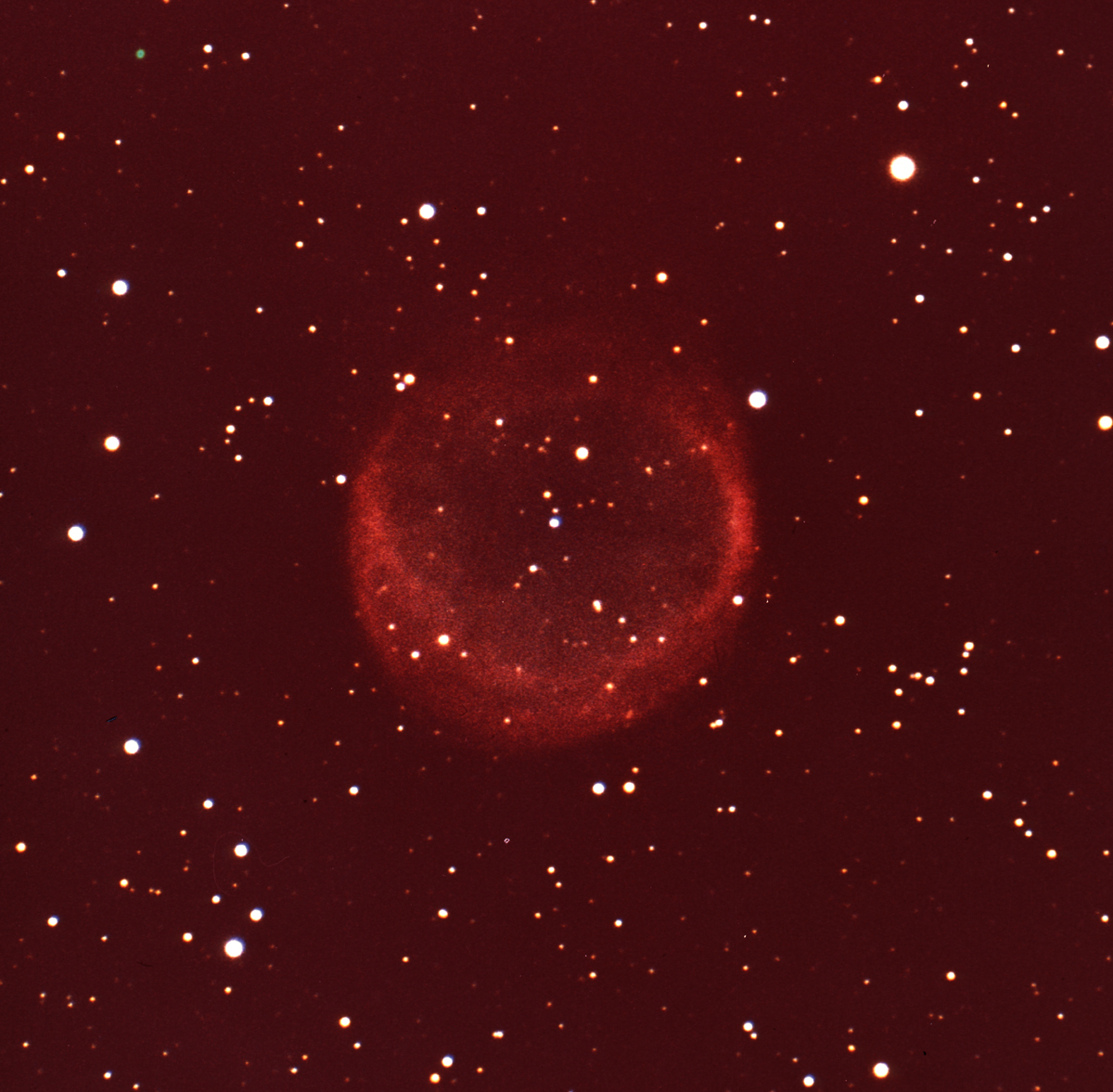 The bubble of gas was given off by the star at the center of the nebula. This photograph was taken with Palomar's 48-inch Schmidt telescope which is now known as the Samuel Oschin Telescope.
The bubble of gas was given off by the star at the center of the nebula. This photograph was taken with Palomar's 48-inch Schmidt telescope which is now known as the Samuel Oschin Telescope.
 The bubble of gas was given off by the star at the center of the nebula. This photograph was taken with Palomar's 48-inch Schmidt telescope which is now known as the Samuel Oschin Telescope.
The bubble of gas was given off by the star at the center of the nebula. This photograph was taken with Palomar's 48-inch Schmidt telescope which is now known as the Samuel Oschin Telescope.
Labels:
astrophotos,
nebulae,
Samuel Oschin Telescope
Wednesday, June 9, 2010
Pics from last weekend's TMT event at Palomar
Last Saturday at Palomar we had a talk by TMT scientist Tony Travouillon on the process of choosing the site for the Thirty Meter Telescope. About 90 people were able to attend.
That's Tony below near the end of his talk:
 Left to right: TMT Project Manager Gary Sanders, TMT Telescope Research Engineer Warren Skidmore, Palomar's Scott Kardel, TMT Environment Control Scientist Tony Travouillon. Photo by Richard Garcia.
Left to right: TMT Project Manager Gary Sanders, TMT Telescope Research Engineer Warren Skidmore, Palomar's Scott Kardel, TMT Environment Control Scientist Tony Travouillon. Photo by Richard Garcia.
After the talk attendees were invited to a star party on the grounds of the observatory's outreach center under clear, dark skies.
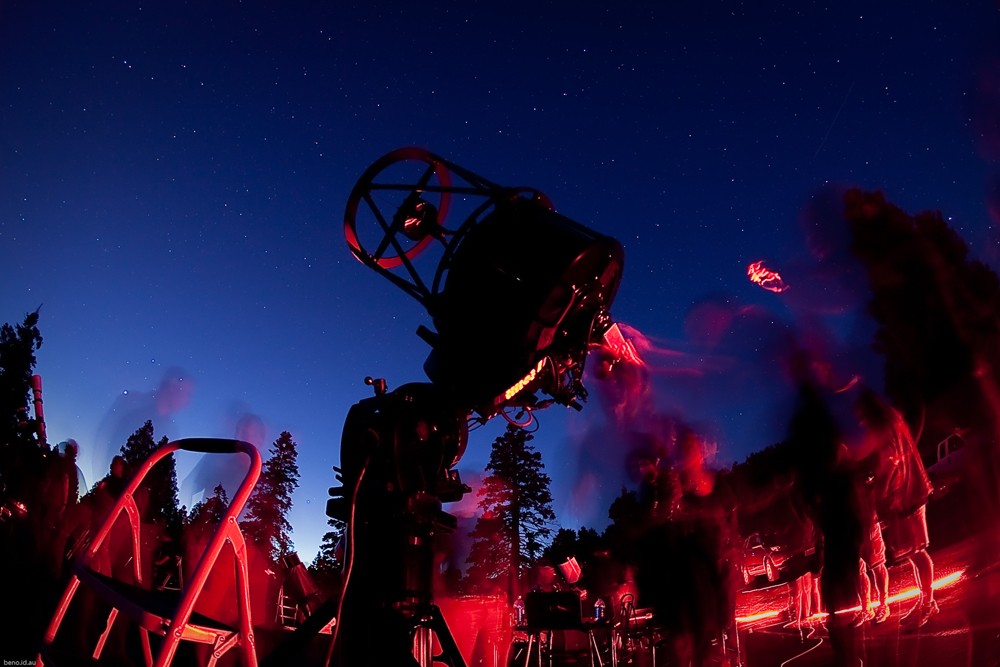 The people are blurred, while this PlaneWave Instruments telescope seems to be motionless in this time-exposure photo by Ben Orchard. In reality the telescope was moving too as it slowly tracked to counteract Earth's rotation.
The people are blurred, while this PlaneWave Instruments telescope seems to be motionless in this time-exposure photo by Ben Orchard. In reality the telescope was moving too as it slowly tracked to counteract Earth's rotation.
That's Tony below near the end of his talk:
 Left to right: TMT Project Manager Gary Sanders, TMT Telescope Research Engineer Warren Skidmore, Palomar's Scott Kardel, TMT Environment Control Scientist Tony Travouillon. Photo by Richard Garcia.
Left to right: TMT Project Manager Gary Sanders, TMT Telescope Research Engineer Warren Skidmore, Palomar's Scott Kardel, TMT Environment Control Scientist Tony Travouillon. Photo by Richard Garcia.After the talk attendees were invited to a star party on the grounds of the observatory's outreach center under clear, dark skies.
 The people are blurred, while this PlaneWave Instruments telescope seems to be motionless in this time-exposure photo by Ben Orchard. In reality the telescope was moving too as it slowly tracked to counteract Earth's rotation.
The people are blurred, while this PlaneWave Instruments telescope seems to be motionless in this time-exposure photo by Ben Orchard. In reality the telescope was moving too as it slowly tracked to counteract Earth's rotation.
Labels:
public outreach,
thirty meter telescope
Monday, June 7, 2010
Palomar History Photo of the Week - June 7, 2010
The Hale Telescope has been the focus of many of our history photos of the week. It is time to have a look at some of the other telescopes and locations at Palomar Observatory.
The Oscar G. Mayer Memorial Building, which houses Palomar's 60-inch telescope, was built in 1968-69. Here is an aerial photograph showing the construction site before any work had begun on assembling the dome.
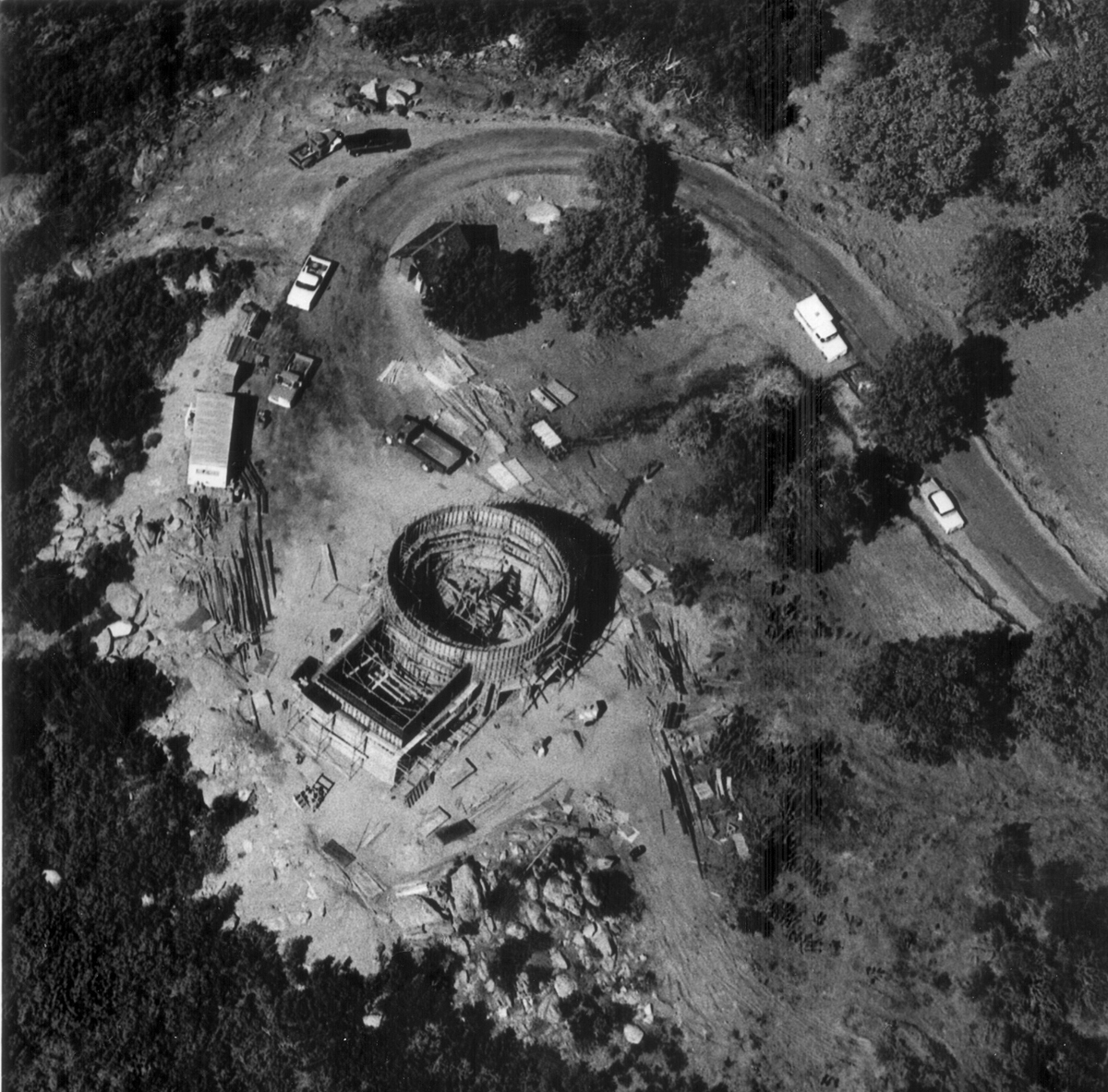 The photo comes from Robert Gandolfi. Back in the day he worked for Western Gear Corporation, one of the contractors on the project.
The photo comes from Robert Gandolfi. Back in the day he worked for Western Gear Corporation, one of the contractors on the project.
To put things in perspective, here is a modern aerial photo showing the completed building and dome:
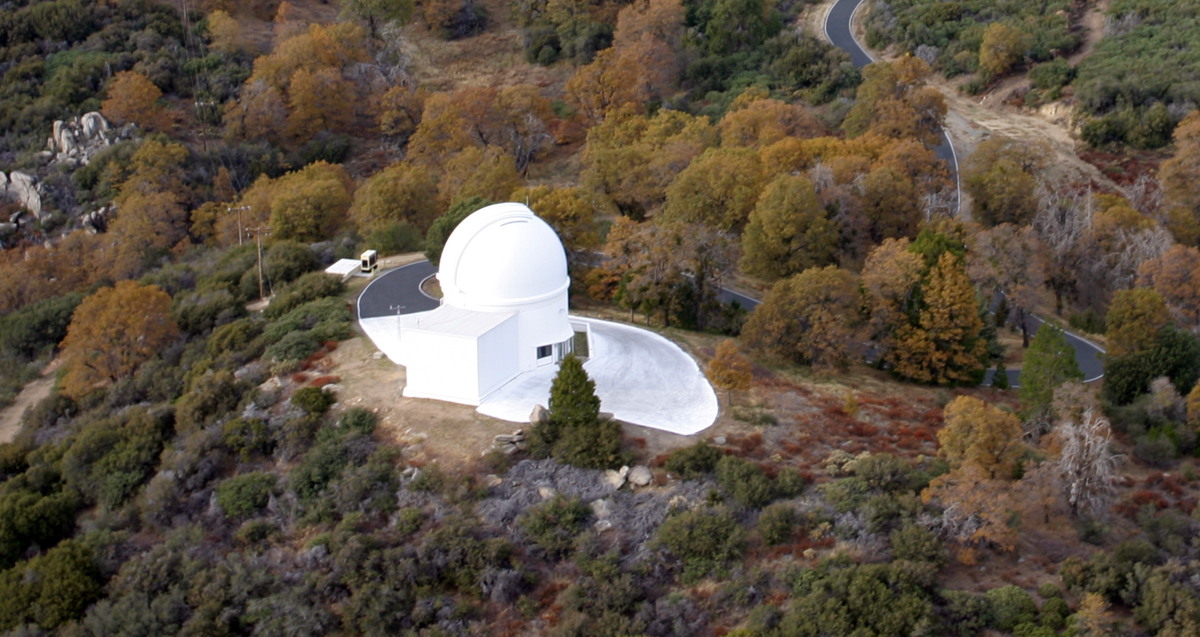
The Oscar G. Mayer Memorial Building, which houses Palomar's 60-inch telescope, was built in 1968-69. Here is an aerial photograph showing the construction site before any work had begun on assembling the dome.
 The photo comes from Robert Gandolfi. Back in the day he worked for Western Gear Corporation, one of the contractors on the project.
The photo comes from Robert Gandolfi. Back in the day he worked for Western Gear Corporation, one of the contractors on the project.To put things in perspective, here is a modern aerial photo showing the completed building and dome:

Saturday, June 5, 2010
Palomar Zoo

The Galaxy Zoo is coming to Palomar on Sunday night. If you are not familiar with the program here is a short introduction from their website:
The original Galaxy Zoo was launched in July 2007, with a data set made up of a million galaxies imaged with the robotic telescope of the Sloan Digital Sky Survey (SDSS). With so many galaxies, the team thought that it might take at least two years for visitors to the site to work through them all. Within 24 hours of launch, the site was receiving 70,000 classifications an hour, and more than 50 million classifications were received by the project during its first year, from almost 150,000 people.
Sunday night the 200-inch Hale Telescope will be used to follow-up on what some of the Galaxy Zoo team has discovered. Specifically, the team will be looking to confirm gravitational lens candidates. A gravitational lens is produced when the mass of an object, like a galaxy cluster, bends and magnifies the light of a more distant objects behind behind it. Here is an illustration to show how that happens:
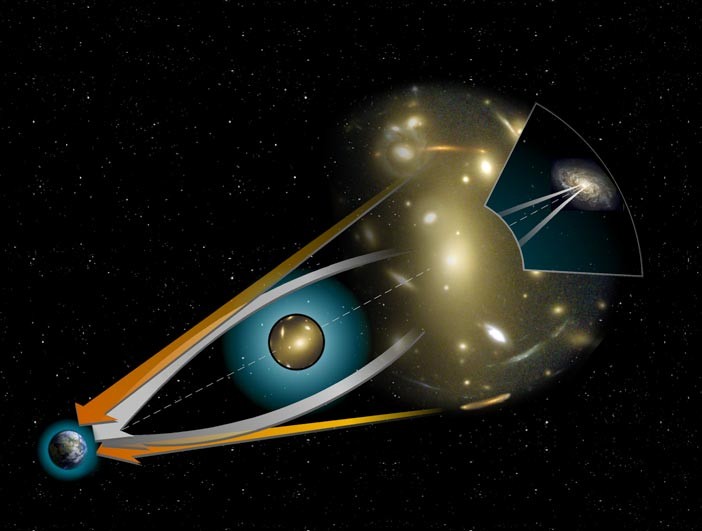
By carefully studying how the light of the distant objects is bent/magnified/distorted it is possible to map out the distribution of matter and dark matter. For more information have a look at their Zooite Guide to Strong Gravitational Lenses.
From the research team observing at Palomar:
Through visual inspection of ~900,000 galaxies in the SDSS, Galaxy Zoo participants are discovering potential lens candidates at a prodigious rate. Our sample includes blue arcs and multiply imaged sources around early-type galaxies. The data will provide key constraints on the dynamics and mass distribution of both luminous and dark matter in a large sample of intermediate redshift elliptical galaxies.The Zoo project also running The Hunt For Supernovae which is helping to discover supernovae and transients first photographed with Palomar's Samuel Oschin Telescope via the Palomar Transient Factory project. Head on over to check it out.
Friday, June 4, 2010
Astrophoto Friday: Quaoar Discovered
Eight years ago today Caltech astronomers Chad Trujillo and Michael Brown, using Palomar's 48-inch Samuel Oschin Telescope, discovered the object now known as 50000 Quaoar.
Today's Astrophoto Friday image is an animated gif of three discovery images that show Quaoar's motion against the background of the sky.
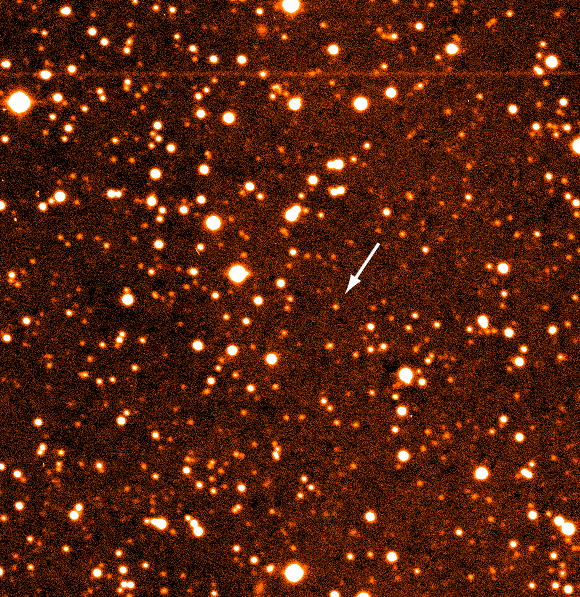 Quaoar is part of a population of objects that lie out beyond the orbit of Neptune that make up what is known as the Kuiper Belt. The artwork below illustrates the sizes of the largest known worlds of these icy bodies, with a section of Earth at the bottom for scale.
Quaoar is part of a population of objects that lie out beyond the orbit of Neptune that make up what is known as the Kuiper Belt. The artwork below illustrates the sizes of the largest known worlds of these icy bodies, with a section of Earth at the bottom for scale.

Quaoar has one known moon, Weywot. Studies of Weywot's orbit about Quaoar have led to estimates of its mass an density. Surprisingly, Quaoar has a density more like rock than ice.
Today's Astrophoto Friday image is an animated gif of three discovery images that show Quaoar's motion against the background of the sky.
 Quaoar is part of a population of objects that lie out beyond the orbit of Neptune that make up what is known as the Kuiper Belt. The artwork below illustrates the sizes of the largest known worlds of these icy bodies, with a section of Earth at the bottom for scale.
Quaoar is part of a population of objects that lie out beyond the orbit of Neptune that make up what is known as the Kuiper Belt. The artwork below illustrates the sizes of the largest known worlds of these icy bodies, with a section of Earth at the bottom for scale.
Quaoar has one known moon, Weywot. Studies of Weywot's orbit about Quaoar have led to estimates of its mass an density. Surprisingly, Quaoar has a density more like rock than ice.
Subscribe to:
Posts (Atom)
